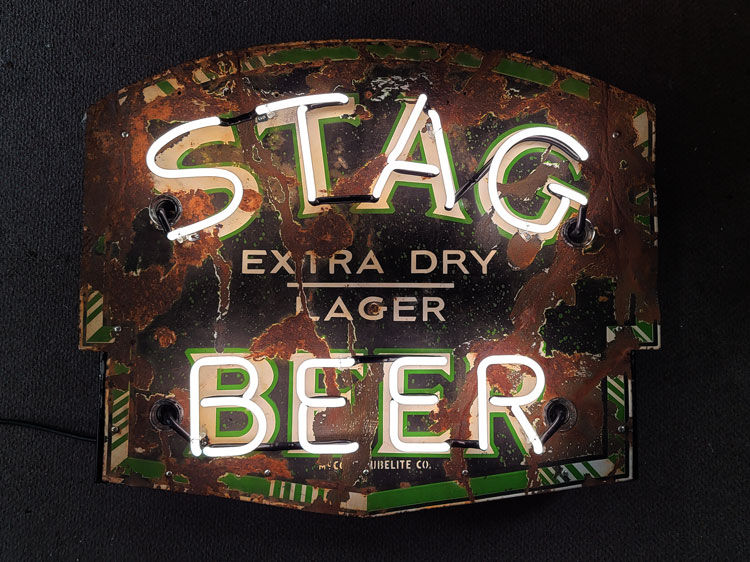
Restoration project.
Manufactured by McCord Tubelite Co. East St. Louis Illinois around 1939.
This porcelain Stag Beer Extra Dry Lager neon sign is unusual since the logo used green instead of the traditional red.
We used Tecnolux 12mm #6 Natural White glass on the sign to bring out the green porcelain.
Stag Beer has a rich history rooted in Belleville, Illinois, where it has become a beloved local brand with a significant legacy in the American brewing industry.
Early History
Stag Beer traces its origins back to 1851 when the Western Brewery was established in Belleville by Adam Lemp. This brewery, one of the first of its kind in the region, laid the groundwork for the area’s brewing industry. Belleville, with its significant German immigrant population, quickly became a hub for beer production.
Formation and Growth
The brand known today as Stag Beer was officially born in 1907 when the Western Brewery merged with the Gruenewaelder Brewery, another prominent Belleville brewery founded by George M. Gruenewaelder. This merger led to the creation of the National Brewery Company. Shortly thereafter, the brewery introduced Stag Beer, named to evoke the image of a robust, noble stag, symbolizing strength and purity.
Prohibition and Adaptation
The Prohibition era (1920-1933) posed significant challenges for the beer industry nationwide. However, the National Brewery Company, like many others, adapted by producing non-alcoholic beverages and other products. This adaptability allowed the company to survive the Prohibition years and resume beer production once the laws were repealed.
Post-Prohibition Era
After Prohibition ended, Stag Beer quickly regained its popularity. Throughout the mid-20th century, it became known for its quality and affordability. The beer was especially popular in the Midwest, where it became a staple in local bars and homes.
Modern Era and Ownership Changes
In the latter half of the 20th century, the beer industry underwent significant consolidation, and Stag Beer changed ownership multiple times. In 1954, the National Brewery Company was acquired by the Carling Brewing Company. Later, in 1979, G. Heileman Brewing Company purchased the brand. Under Heileman’s ownership, Stag Beer continued to thrive and maintained its reputation as a beloved regional beer.
The brand underwent further ownership changes in the 1990s when Heileman was acquired by Stroh Brewery Company in 1996, and then by Pabst Brewing Company in 1999. Despite these changes, Stag Beer remained a constant presence in the Midwest.
Cultural Impact and Legacy
Stag Beer holds a special place in the hearts of many in Belleville and the surrounding areas. Its long history and local roots have made it a symbol of regional pride. The beer is celebrated not just for its taste, but for its historical significance and the sense of community it fosters.
In recent years, there has been a resurgence of interest in heritage brands like Stag. The craft beer movement has brought renewed attention to traditional beers, and Stag’s enduring quality and classic appeal have helped it maintain a loyal following.
Conclusion
From its beginnings in the mid-19th century to its status as a regional icon, Stag Beer’s history is intertwined with the story of Belleville, Illinois. It stands as a testament to the enduring appeal of local, quality beer and the rich brewing heritage of the American Midwest.

Comments